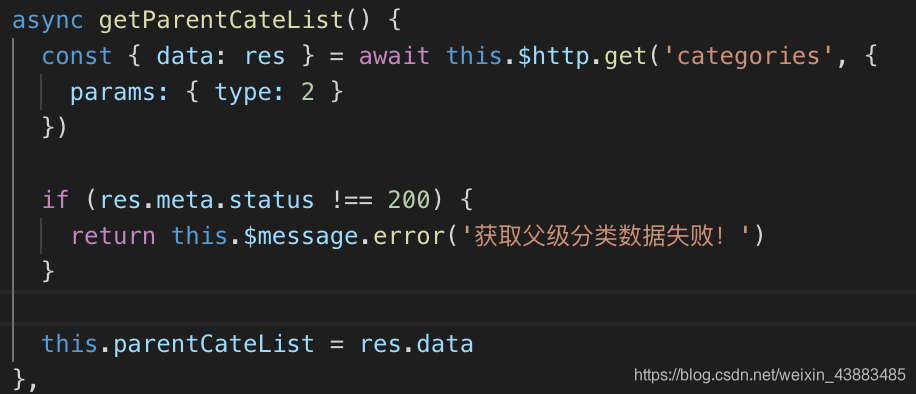- Promise用法
- 接口调用 fetch 用法
- 接口调用 axios 用法
- 接口调用 async/await 用法
一 Promise用法
Promise
resolve成功状态
reject拒绝状态
then是前面返回promise的处理
Promise的相关概念
es6新语法 用来处理异步编程
promise是一个对象 可以获取异步操作的消息
好处:
- 可以避免多层异步调用嵌套的问题(回调地狱)
- 提供了简洁的API 使得控制异步操作更加容易
基于promise发送ajax请求
// 封装一个独立的函数
function queryData(){
return pro = new Promise((resolve, reject)=>{
var xhr = new XMLHttpRequest();
xhr.onreadystatechange = () =>{
if(xhr.readyState != 4) return;
if(xhr.readyState == 4 && xhr.status == 200){
// 处理正常的情况
resolve(xhr.responsetext)
}else{
// 处理异常情况
reject('服务器错误')
}
}
xhr.open('get', url); // 准备发送前的参数
xhr.send(null);
});
}
// 单个ajax请求
queryData('http://localhost:3000/data')
.then((data)=>{
console.log(data)
},(info)=>{
console.log(info)
})
// 多个ajax请求 并且保证顺序
queryData('http://localhost:3000/data')
.then((data)=>{
console.log(data)
return queryData('http://localhost:3000/data1')
})
.then((data)=>{ // 得到上一步的异步任务的结果
console.log(data)
return queryData('http://localhost:3000/data2')
})
.then((data)=>{
console.log(data)
})
then 参数中的函数返回值
返回promise实例对象—返回的该实例对象会调用下一个then
返回普通值—返回的普通值会直接传递给下一个then 通过then参数中函数的参数接收该值
promise常用的API
// 打印promise的详细信息
console.dir(Promise)
-
实例方法
.then() 得到异步任务的正确结果
.catch() 得到异常信息
.finally() 成功与否都会执行 -
对象方法
Promise.all() 并发处理多个异步任务 所有任务都执行完成才能得到结果
Promise.race() 并发处理多个异步任务 只要有一个任务完成就能得到结果
二 接口调用 fetch 用法
基本特性
- 更加简单的数据获取方式 功能更强大 更灵活 可以看做是xhr的升级版
- 基于promise实现
fetch('http://localhost:3000/data').then(data=>{
// text()方法属于fetch API的一部分 它返回一个promise实例对象 得到后台返回的数据
return data.text()
})then(data=>{
console.log(data)
})
fetch请求参数 常用参数配置
method(String):HTTP 请求方法 默认为 GET(GET,POST,PUT,DELETE)
body(String):HTTP请求参数
headers(Object):HTTP的请求头 默认为{}
GET请求
fetch('http://localhost:3000/data?id=1',{method:'get'}).then(data=>{
return data.text()
})then(data=>{
console.log(data)
})
GET后台接口
app.get('/data',(req,res)=>{
res.send('传统url传递参数' + req.query.id)
})
DELETE 请求
fetch('http://localhost:3000/list/1',{method:'delete'}).then(data=>{
return data.text()
})then(data=>{
console.log(data)
})
DELETE后台接口
app.delete('/list/:id',(req,res)=>{
res.send('restful形式的url传递参数' + req.params.id)
})
POST请求 传统参数
fetch('http://localhost:3000/lists',{
method:'post',
body:'uname=lisi&pwd=222',
headers:{
'Content-Type':'application/x-www-form-urlencoded'
}
}).then(data=>{
return data.text()
})then(data=>{
console.log(data)
})
POST后台接口
app.post('/lists',(req,res)=>{
res.send('post请求' + req.body.uname + req.body.pwd)
})
// body是由body-parser中间件提供的
POST请求 json格式
fetch('http://localhost:3000/lists',{
method:'post',
body:JSON.stringify({
uname:'lisi',
pwd:222
}),
headers:{
'Content-Type':'application/json'
}
}).then(data=>{
return data.text()
})then(data=>{
console.log(data)
})
put请求与post请求类似
fetch响应数据格式
text() 将返回体处理成字符串类型
json() 返回结果和JSON.parse(responseText) 一样
json格式使用将上面的text()换成json()就可以 后台返回的数据格式就应该是json格式
三 接口调用 axios 用法
基于promise用于浏览器和node.js的HTTP客户端
基本特性:
- 支持浏览器和node
- 支持promise
- 能拦截请求和响应
- 自动转换JSON数据
先下载 axios 包
axios.get('http://localhost:3000/data').then(ret=>{
// data属性是固定的 用于获取后台响应的数据
console.log(data.ret)
})
后台接口
app.get('/data',(req,res)=>{
res.send('hello axios')
})
axios常用API
get post put delete
GET传递参数
通过URL传递参数
通过params选项传递参数
axios.get('http://localhost:3000/data?id=1').then(ret=>{
console.log(data.ret)
})
后台接口
app.get('/data',(req,res)=>{
res.send('axios get传递参数' + req.query.id)
})
也可以通过restful方式传递参数 参考fetch的delete方法
params传递参数
axios.get('http://localhost:3000/data',{
params:{ // 可以传递多个参数 比较方便
id:1
}
}).then(ret=>{
console.log(data.ret)
})
后台接口
app.get('/data',(req,res)=>{
res.send('axios get传递参数' + req.query.id)
})
DELETE传递参数与GET类似
POST传递参数
默认传递的是JSON格式的数据 需要后台提供支持
axios.post('http://localhost:3000/data',{
uname:'lisi',
pwd:222
}).then(ret=>{
console.log(data.ret)
})
后台接口
app.post('/data',(req,res)=>{
res.send('axios post传递参数' + req.body.uname + req.body.id)
})
// 通过 URLSearchParams 传递参数
// 如果后台支持json使用上面那种方法 如果两种都支持还是使用上面那种方法
var params = new URLSearchParams();
params.append('uname', 'lisi')
params.append('pwd', '222')
axios.post('http://localhost:3000/data',params).then(ret=>{
console.log(data.ret)
})
后台接口
app.post('/data',(req,res)=>{
res.send('axios post传递参数' + req.body.uname + req.body.id)
})
put请求与post请求类似
axios的响应结果
data 实际响应回来的数据
headers 响应头信息
status 响应状态码
statusText 响应状态信息
axios的全局配置
// 超时时间
axios.defaults.timeout = 5000;
// 配置请求的基准URL地址
axios.defaults.baseurl = 'http://localhost:3000'
// 请求头信息
axios.defaults.headers['token'] = 'xxxxx'
axios拦截器
请求拦截器 在请求发出之前配置一些信息
// 添加请求拦截器 通过拦截器可以控制所有请求
axios.interceptors.request.use(config=>{
config.headers.token = 'xxx' // 配置请求头
return config
},err=>{
console.log(err)
})
响应拦截器 在获取数据之前对数据做一些加工处理
// 添加响应拦截器
axios.interceptors.response.request.use(res=>{
console.log(res)
return res
},err=>{
console.log(err)
})
四 接口调用 async/await 用法
async/await 是ES7引入的新语法 可以更加方便的进行异步操作
async关键字同于函数上 async函数的返回值是Promise实例对象
await关键字用于async函数当中 await可以得到异步的结果
async function queryData(id){
const ret = await.get('xxxx')
return ret
}
queryData.then(ret=>{
console.log(ret)
})
实际项目中的应用场景

处理多个异步请求
async function queryData(id){
const info = await axios.get('xxxx1')
const ret = await.get('xxxx2?info=' + info.data)
return ret.data
}
queryData.then(data=>{
console.log(data)
})
